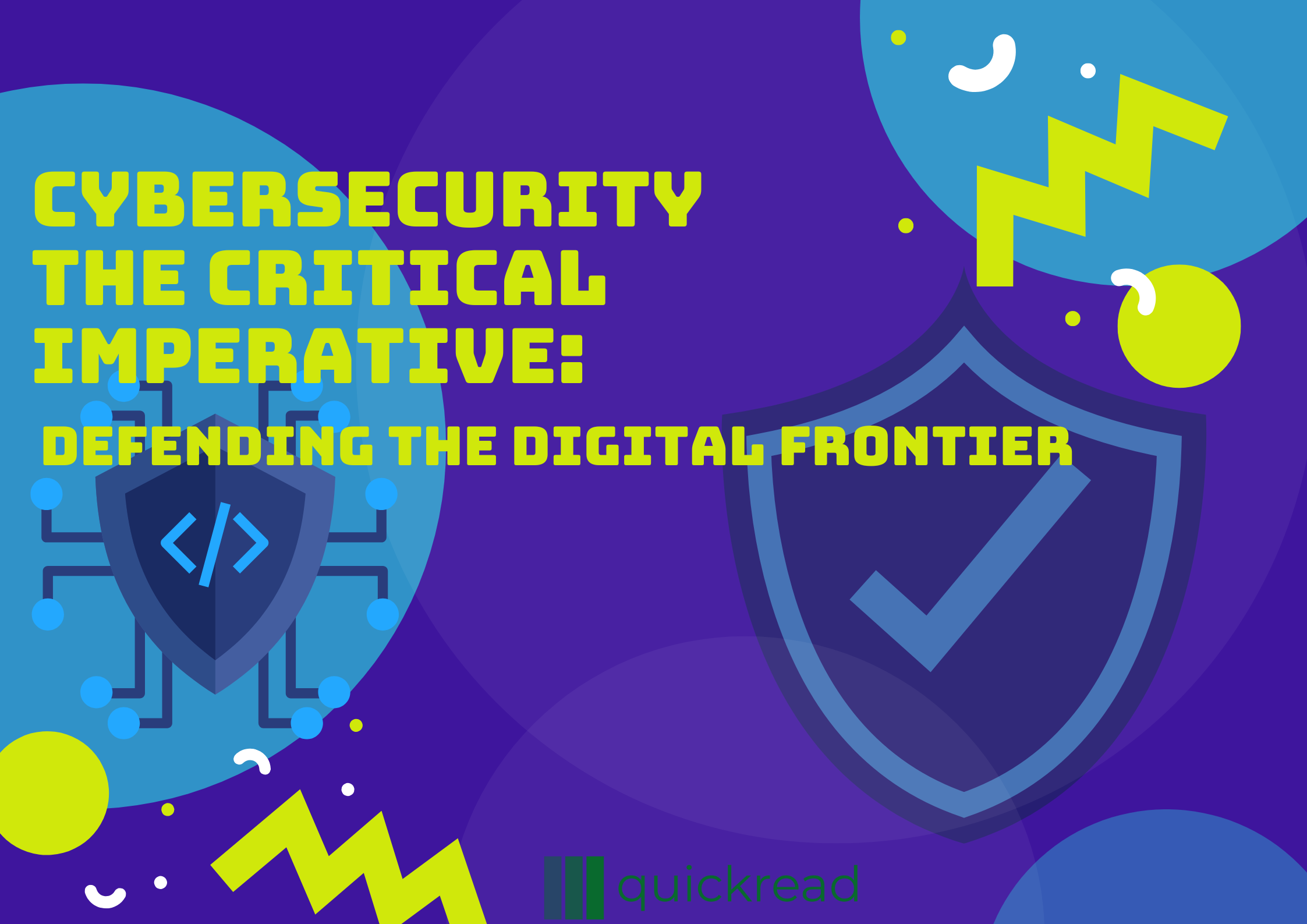Last updated on July 4th, 2023
Introduction
The significance of strong cybersecurity practices cannot be emphasized in the linked world of today, when technology penetrates every part of our lives. The rise of digitalization has brought immense convenience, efficiency, and innovation, but it has also introduced a new set of risks and vulnerabilities. Cybersecurity has become a critical necessity, protecting individuals, organizations, and nations from malicious actors seeking to exploit weaknesses in our digital infrastructure. In this article, we delve deeper into the significance of cybersecurity and explore the measures we must take to secure our digital frontier.
The Cyber Threat Landscape
The evolving cyber threat landscape presents numerous challenges for individuals, businesses, and governments. Malicious actors are continuously refining their techniques to target vulnerabilities and exploit unsuspecting victims. Some of the prominent threats include:
- Malware: Malicious software, such as viruses, worms, trojans, and ransomware, poses a significant risk. These programs can infiltrate systems, steal data, disrupt operations, and demand ransom payments, causing financial and reputational harm.
- Phishing and Social Engineering: Cybercriminals often employ deceptive tactics to trick individuals into revealing sensitive information or performing unauthorized actions. Phishing emails, fake websites, and social engineering techniques prey on human vulnerability and trust to gain unauthorized access.
- Insider Threats: Employees or insiders with authorized access can intentionally or unintentionally compromise data security. It is essential for organizations to implement robust access controls, monitor user activities, and educate employees about their role in maintaining cybersecurity.
- Advanced Persistent Threats (APTs): APTs are highly targeted and sophisticated attacks typically carried out by well-funded and organized groups. These attackers employ advanced techniques, including zero-day exploits and custom malware, to infiltrate networks and gain persistent access.
The Need for Cybersecurity
- Protection of Personal Data: In an era of widespread data breaches, safeguarding personal information is of utmost importance. Cybersecurity measures, such as encryption, secure data storage, and access controls, ensure that personal data remains confidential and protected from unauthorized access.
- Defense of Businesses: Cyberattacks can have severe consequences for organizations, regardless of their size. Beyond financial losses, attacks can disrupt operations, lead to intellectual property theft, damage brand reputation, and result in legal liabilities. Effective cybersecurity practices, including network segmentation, regular vulnerability assessments, and incident response planning, help mitigate these risks.
- National Security: The digitization of critical infrastructure, government systems, and military operations has made nations more vulnerable to cyber threats. Attacks on power grids, communication networks, and defense systems can have devastating consequences, impacting economic stability, public safety, and national defense capabilities. Robust cybersecurity measures are essential to protect critical infrastructure and preserve national security.
Essential Cybersecurity Practices
- Strong Passwords and Authentication: Weak passwords are easily compromised, making strong authentication crucial. Individuals and organizations should adopt complex passwords or passphrases, enable multi-factor authentication (MFA), and consider using password managers to securely store credentials.
- Regular Software Updates: Software vulnerabilities are often exploited by attackers. Regularly updating operating systems, applications, and firmware ensures that known security flaws are patched, reducing the risk of exploitation.
- Employee Education and Awareness: Human error remains a significant factor in successful cyberattacks. Organizations should conduct regular cybersecurity awareness training programs to educate employees about the latest threats, social engineering techniques, and safe computing practices. Employees should be trained to recognize phishing attempts, avoid suspicious websites, and handle sensitive data securely.
- Firewalls and Intrusion Detection Systems: Deploying firewalls and intrusion detection systems (IDS) helps protect networks from unauthorized access and malicious activities. These security measures monitor incoming and outgoing traffic, identify suspicious behavior, and block or alert against potential threats.
- Data Encryption: Encryption converts data into an unreadable format, providing an additional layer of protection against unauthorized access. Strong encryption algorithms should be used to encrypt sensitive data, both in transit and at rest. This safeguards information even if it is intercepted or stolen.
- Regular Data Backups: Data backups are essential for mitigating the impact of data loss incidents, including ransomware attacks or hardware failures. Multiple copies of critical data should be stored securely, both offline and in the cloud, following a well-defined backup strategy. Regular testing of backups ensures data integrity and quick recovery in case of an incident.
- Incident Response and Disaster Recovery Planning: Developing a robust incident response plan and disaster recovery strategy is vital. This includes establishing clear roles and responsibilities, defining incident escalation procedures, implementing an effective communication plan, and regularly testing the response plan to ensure readiness in the face of a cyber incident.
Frequently asked questions
Q1. Why is cyber security important in the digital world?
Ans: Cybersecurity is crucial in the digital world to protect sensitive information, prevent unauthorized access to systems, and safeguard against cyber threats and attacks that can lead to financial loss, data breaches, and damage to reputation.
Q2. What are the 3 principles of cyber defense?
Ans:
The three principles of cyber defense are:
- Prevention: Implementing measures to prevent cyber threats and attacks.
- Detection: Identifying and detecting any unauthorized or malicious activities in the network.
- Response: Taking immediate action to mitigate and respond to cyber incidents effectively.
Q3. What is defense in cyber security?
Ans: Defense in cybersecurity refers to the measures and strategies implemented to protect computer systems, networks, and data from unauthorized access, attacks, or damage. It involves a combination of proactive measures such as firewalls, encryption, and user authentication, as well as reactive measures like incident response and vulnerability patching.
Q4. What are the 5 types of cyber security?
Ans: There are various types of cybersecurity measures and approaches that organizations and individuals can implement to protect themselves against cyber threats. While it’s not an exhaustive list, here are five common types of cybersecurity:
- Network Security: Network security focuses on protecting the integrity, confidentiality, and availability of computer networks and their associated data. It involves measures such as firewalls, intrusion detection systems (IDS), virtual private networks (VPNs), and network segmentation to prevent unauthorized access, detect malicious activities, and ensure secure communication.
- Application Security: Application security involves securing software applications, both off-the-shelf and custom-built, against potential vulnerabilities and threats. This includes implementing secure coding practices, conducting regular security testing and code reviews, and employing web application firewalls (WAFs) to safeguard against attacks like cross-site scripting (XSS) and SQL injection.
- Information Security: Information security focuses on protecting sensitive and valuable information from unauthorized access, disclosure, alteration, or destruction. It encompasses practices such as data encryption, access control mechanisms, secure data storage and transmission, and user awareness and training to ensure proper handling of information assets.
- Endpoint Security: Endpoint security involves securing individual devices such as computers, laptops, smartphones, and other endpoints from cybersecurity threats. This typically involves using antivirus and anti-malware software, implementing device encryption, enforcing strong authentication mechanisms, and regularly patching and updating software to address known vulnerabilities.
- Cloud Security: Cloud security deals with protecting data, applications, and infrastructure deployed in cloud environments. It includes measures such as secure cloud configuration, data encryption, access controls, and monitoring of cloud services.
It’s important to note that these types of cybersecurity measures are interconnected, and a holistic cybersecurity approach involves implementing multiple layers of defense to mitigate various risks and threats.
Conclusion
In an increasingly digitized world, cybersecurity is an ongoing battle that requires constant vigilance and proactive measures. The complex and ever-evolving cyber threat landscape necessitates a comprehensive approach to protect individuals, businesses, and nations. By implementing strong cybersecurity practices, such as employing robust authentication, educating employees, leveraging encryption, and establishing incident response capabilities, we can fortify our digital infrastructure and minimize the risks associated with cyberattacks. Let us unite in our commitment to cybersecurity and work together to secure our interconnected world


